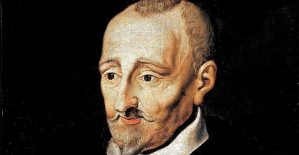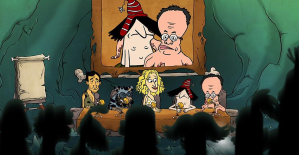The imbroglio archaeological was so great that the University of Cordoba was appealed in 2009 to quotes from Albert Einstein and Li Hongzhi, the founder of the philosophy of Falun Gong, to try to explain it in his report Of Isturgi et Iliturgi Confusione. “Nothing is random”, he pointed out, what that came to mean that there has been a lot of interest hidden in this story without resolving that arises in 206 bc and arrives until our days. Fakes included.
MORE INFORMATION
Rome against Carthage, archaeology of a battleThe problem —that has been solved now by the Institute of Archaeology of the University of Jaén— was the following: there were two cities iberians calls Iliturgi and Isturgi. It was known that they were located in the interior of the province of jaén, but no one could prove its exact location. And two towns, Andujar and Mengibar —apart about 20 kilometers and archaeological sites of their own—, claimed to be the heirs of Iliturgi. Both fought for to be the direct descendants of this old hispanic settlement, because this iberian city was a kind of Numancia andalusian front of the roman troops of Escipion the African. Isturgi, in contrast, was a simple pottery center without so much epic.
The other two towns of Jaén, who use the name of the iliturgitano in shops, clubs, or institutions, have wielded since the SIXTEENTH century documents and two “testing materials” (roman inscriptions) that would demonstrate that you are the authentic Iliturgi. Until someone discovered that one of the traces was a forgery and that on the other had doubts.
expand photo Glandes of lead found in the environment of the cerro de La Muela, Mengíbar, where occurred the siege of Iliturgi. UNIVERSITY INSTITUTE OF RESEARCH IN ARCHAEOLOGY IBÉRICA, UNIVERSITY OF JAÉNThe story is complicated when Ambrosio Morales —envoy of Felipe II— found in Valdemao (Lugo), the body of saint Euphrasius, who identified himself as bishop of Iliturgi, emphasizing that this city was Andújar. From there, several authors repeat it. But in 1635 he was found, according to a document of the time, “three-quarters of a league of Andujar, in the site called Los Villares, a based very large Betpas jasper” where we read: “Res publica Isturgitanorum”, or what is the same, Andujar is Isturgi.
In 1960, archaeologists Antonio Blanco and Gaspar de Lachica found another inscription in Mengibar dedicated to the “people iliturgitano to its founder”, Tiberius Sempronius Graco, which gave the story another turn: the iberian city was returning to the field of Mengibar. However, the inscription unearthed (Lachica was Mengíbar) caused doubts. In it is recorded: “To Tiberius Sempronius Graco, its founder [deductor] the people iliturgitano”, but the word “deductor” does not exist in any entry known roman, although their use is correct. In addition, the brother of Lachica was a sculptor. For some authors it was a forgery. For others, not. “If you want to falsify something, not get a word that is not used, said many,” recalls Juan Pedro Bellón, director of the current excavations of Iliturgi.
The research of the roman siege to an iberian settlement in Mengibar began in 2012, but no one knew what city it was. The dug was ravaged during the Second Punic War (between the carthaginians and the romans between 218 to 201 bc) and against she had used heavy artillery with large projectiles.
To compare the remains of the weapons found in the siege of Mengíbar with those found in Baecula (Santo Tomé, also in Jaén), the archaeologists discovered that they were of the same type, the same that was used by Scipio, the one that was used in 206. C. Then if the ammunition matched, it was clear that we were faced with the same army in the two great battles fought in Jaén: Mengibar was Iliturgi.
The 2009 report of the University of Cordoba concluded: the experts from the SEVENTEENTH century “used false cronicones, filling his writings, inventions and lies that have filled up with real confusion these studies”, creating “a real outrageous institutionalized”. Until the University of Jaén has found the projectiles that resolve to finally clean up the mess.

 United States: divided on the question of presidential immunity, the Supreme Court offers respite to Trump
United States: divided on the question of presidential immunity, the Supreme Court offers respite to Trump Maurizio Molinari: “the Scurati affair, a European injury”
Maurizio Molinari: “the Scurati affair, a European injury” Hamas-Israel war: US begins construction of pier in Gaza
Hamas-Israel war: US begins construction of pier in Gaza Israel prepares to attack Rafah
Israel prepares to attack Rafah First three cases of “native” cholera confirmed in Mayotte
First three cases of “native” cholera confirmed in Mayotte Meningitis: compulsory vaccination for babies will be extended in 2025
Meningitis: compulsory vaccination for babies will be extended in 2025 Spain is the country in the European Union with the most overqualified workers for their jobs
Spain is the country in the European Union with the most overqualified workers for their jobs Parvovirus alert, the “fifth disease” of children which has already caused the death of five babies in 2024
Parvovirus alert, the “fifth disease” of children which has already caused the death of five babies in 2024 Falling wings of the Moulin Rouge: who will pay for the repairs?
Falling wings of the Moulin Rouge: who will pay for the repairs? “You don’t sell a company like that”: Roland Lescure “annoyed” by the prospect of a sale of Biogaran
“You don’t sell a company like that”: Roland Lescure “annoyed” by the prospect of a sale of Biogaran Insults, threats of suicide, violence... Attacks by France Travail agents will continue to soar in 2023
Insults, threats of suicide, violence... Attacks by France Travail agents will continue to soar in 2023 TotalEnergies boss plans primary listing in New York
TotalEnergies boss plans primary listing in New York La Pléiade arrives... in Pléiade
La Pléiade arrives... in Pléiade In Japan, an animation studio bets on its creators suffering from autism spectrum disorders
In Japan, an animation studio bets on its creators suffering from autism spectrum disorders Terry Gilliam, hero of the Annecy Festival, with Vice-Versa 2 and Garfield
Terry Gilliam, hero of the Annecy Festival, with Vice-Versa 2 and Garfield François Hollande, Stéphane Bern and Amélie Nothomb, heroes of one evening on the beach of the Cannes Film Festival
François Hollande, Stéphane Bern and Amélie Nothomb, heroes of one evening on the beach of the Cannes Film Festival Skoda Kodiaq 2024: a 'beast' plug-in hybrid SUV
Skoda Kodiaq 2024: a 'beast' plug-in hybrid SUV Tesla launches a new Model Y with 600 km of autonomy at a "more accessible price"
Tesla launches a new Model Y with 600 km of autonomy at a "more accessible price" The 10 best-selling cars in March 2024 in Spain: sales fall due to Easter
The 10 best-selling cars in March 2024 in Spain: sales fall due to Easter A private jet company buys more than 100 flying cars
A private jet company buys more than 100 flying cars This is how housing prices have changed in Spain in the last decade
This is how housing prices have changed in Spain in the last decade The home mortgage firm drops 10% in January and interest soars to 3.46%
The home mortgage firm drops 10% in January and interest soars to 3.46% The jewel of the Rocío de Nagüeles urbanization: a dream villa in Marbella
The jewel of the Rocío de Nagüeles urbanization: a dream villa in Marbella Rental prices grow by 7.3% in February: where does it go up and where does it go down?
Rental prices grow by 7.3% in February: where does it go up and where does it go down? Even on a mission for NATO, the Charles-de-Gaulle remains under French control, Lecornu responds to Mélenchon
Even on a mission for NATO, the Charles-de-Gaulle remains under French control, Lecornu responds to Mélenchon “Deadly Europe”, “economic decline”, immigration… What to remember from Emmanuel Macron’s speech at the Sorbonne
“Deadly Europe”, “economic decline”, immigration… What to remember from Emmanuel Macron’s speech at the Sorbonne Sale of Biogaran: The Republicans write to Emmanuel Macron
Sale of Biogaran: The Republicans write to Emmanuel Macron Europeans: “All those who claim that we don’t need Europe are liars”, criticizes Bayrou
Europeans: “All those who claim that we don’t need Europe are liars”, criticizes Bayrou These French cities that will boycott the World Cup in Qatar
These French cities that will boycott the World Cup in Qatar Medicine, family of athletes, New Zealand…, discovering Manae Feleu, the captain of the Bleues
Medicine, family of athletes, New Zealand…, discovering Manae Feleu, the captain of the Bleues Football: OM wants to extend Leonardo Balerdi
Football: OM wants to extend Leonardo Balerdi Six Nations F: France-England shatters the attendance record for women’s rugby in France
Six Nations F: France-England shatters the attendance record for women’s rugby in France Judo: eliminated in the 2nd round of the European Championships, Alpha Djalo in full doubt
Judo: eliminated in the 2nd round of the European Championships, Alpha Djalo in full doubt


















